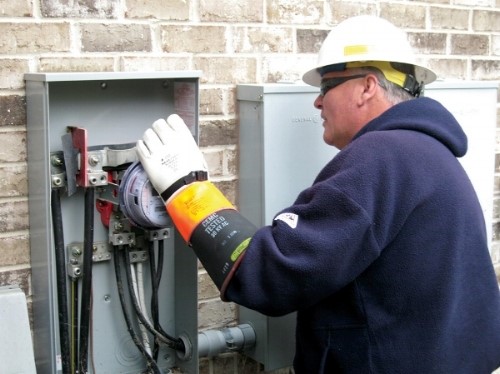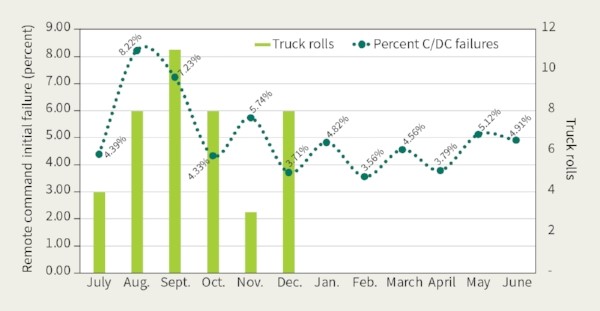
January 3, 2018
Case Study: Remote Disconnections at Middle Tennessee Electric Membership Corp. (MTEMC)
This article was originally published online at T&D World on November 13, 2017.
Amid efforts to reduce operating budgets, increase operational effectiveness and enhance customer care, employees experience greater work satisfaction.
While the capability to disconnect and reconnect meters remotely dramatically improves a utility’s operational effectiveness, customer service level and operating budget, care must be given to designing business processes and applications around this capability to avoid customer service issues and process exceptions. One of the largest electric cooperatives in the U.S., Middle Tennessee Electric Membership Corp. (MTEMC) is reaping the benefits of a well-designed and executed advanced metering infrastructure (AMI) project specifically focused on remote disconnects and reconnects.
MTEMC serves 220,000 electric meters in the area south and east of Nashville, Tennessee. With nearly 12,000 miles (13,312 km) of line in a four-county area, the cooperative has a diverse topography and employs more than 400 employees across seven regional offices. MTEMC embarked on an AMI project to exchange all electric meters with AMI meters, 90% of which would have remote disconnect and reconnect capabilities. As with any AMI solution, several technology components deployed by several companies made up the end-to-end solution.
MTEMC used SAP IS-U for its customer information system (CIS). Utegration Inc. was tasked with SAP system integration and application design for the AMI project. Siemens’ EnergyIP was chosen for the meter data management system application, implemented by the Omnetric Group. Landis & Gyr was chosen to provide the AMI network’s head-end system (Command Center from Landis & Gyr) and AMI meters. Z2 Solutions provided assistance in solution design, vendor selections and business process reviews. The AMI network consists of a RF unlicensed 900-MHz mesh system with 45 backhaul points (collectors) and 1300 signal repeaters (routers).
EXPECTATIONS FROM AMI INVESTMENT
A full AMI rollout is a significant project in terms of time, resources and dollars for any utility. It truly is an investment in the future, and in most cases, these projects are the largest undertaken to date by utilities. Expectations are high, which makes thoughtful business processes and application designs a must to fully leverage the AMI solutions capabilities. Even though the price has continually decreased in recent years, making the business case more attractive, remote disconnect meters are more expensive than their non-remote counterparts, which can add up to millions of dollars in investment for these additional capabilities.

The map shows MTEMC’s service territory with an overlay of AMI RF mesh network.
On the front end of its AMI project, MTEMC outlined some expectations for what it hoped to achieve:
• Increased efficiency in which business processes would be streamlined, manual work reduced or eliminated, truck rolls reduced, and limitations reduced because of the availability of operational personnel, so disconnects for non-pay lists could be executed in a timely manner
• Immediate 24/7 reconnect capabilities, as automation would be used for a payment to trigger an immediate reconnect of a disconnect for non-pay (DNP) account without utility intervention
• Lessened field operation liabilities, especially with collections for non-pay, which can sometimes devolve into confrontations, and fewer truck rolls for DNP and move-in and move-out accounts, which also would lessen the number of accidents, injuries and property damage claims
• A low failure rate, as the systems and processes put into place would be reliable just like the electric system itself, with minimal exceptions to manage
• Reset customer expectations, as customer service would be improved with a faster and more predictable response to reconnections and disconnections, as well as faster remediation of mistakes if, for instance, a wrong meter was disconnected.
Several business processes were improved to enhance efficiencies, productivity and customer experiences. The first improvement came with the move-in and move-out business process. Prior to remote disconnect capabilities, the utility executed move-in reconnects and move-out disconnects manually throughout the business day. With remote capabilities, all move-in reconnects and move-out disconnects are now scheduled and executed simultaneously at the same time each day. MTEMC chose to execute all move-in reconnects at 8 a.m. and all move-out disconnects at 10 a.m.
The remote capabilities essentially eliminated all related truck rolls while the scheduling nature of the design was a huge win in the customer service column. Now MTEMC can tell its customers exactly when to expect their power to be turned on for move-in day and power shut off on move-out day.
DNP ACCOUNTS
Another business process improvement centered around DNP accounts. Prior to remote functionality, disconnects were limited by the number of field personnel. They disconnected one meter after another, and the CIS screens were cumbersome and not user friendly, which resulted in collection efforts always running behind. Once a payment was made by the account holder who had been disconnected, it could take one to two hours before utility personnel returned to re-energize the service because they were most likely collecting in other areas.
During this project, the CIS collection screens were enhanced with needed information, which translated into a smoother and more accurate disconnection process. These application improvements, along with the elimination of dependencies on field operations, enabled collection activities to be fully completed each day. The impact to the call center is a key consideration when accelerating the execution of the collection process. Application functionality enhancements along with real-time payment interfaces enabled automatic reconnection on the receipt of a payment that met or exceeded the delinquent amount.
Now reconnection for non-pay accounts can happen 24/7 without any intervention from the utility. Customers disconnected for non-payment can be reconnected even outside of normal hours of operation without excessive wait times or incurring additional overtime charges.
Reliability of the solution also was a key expectation fully realized. Reliability can be proven after looking at a full year of MTEMC’s AMI operational data in terms of monthly averages:
• Remote connect commands – 1938
• Connect failures – 103
• Remote disconnect commands – 2010
• Disconnect failures – 96
• Total combined command failure rate – 5.03%
•Truck rolls resulting from failures each month – 4.
Prior to AMI remote disconnect and reconnect capabilities, 2900 monthly truck rolls were needed to carry out the necessary work of disconnecting and connecting meters. With the remote disconnect and reconnect capabilities, an average of four truck rolls was required over the last 12 months. The average failure rate of 5.03% would seem to constitute 145 truck rolls, but AMI operations personnel was able to use network tools and patience to minimize actual truck rolls, resulting in zero truck rolls over the last six months.
Patience is required if the network is in a maintenance cycle and just needs time to establish the communications path to and from the meter. This maintenance cycle comes more into play when a mass meter deployment is taking place in a given area. Given time, the remote commands will work as expected. As experience and expertise increase in the AMI operations department, employees can resolve almost all initial failures from the office.

Graphic shows the percent of remote disconnect failures over one year compared to the number of necessary truck rolls to resolve an issue.
TRACKING FAILURES
For tracking the remote disconnect and reconnect failures, Utegration created a custom enhancement in SAP that monitors web services sent to the meter and reports exceptions. If a failure message is returned from the meter or the remote request is never confirmed for a configurable period, an email is triggered to the proper business group to resolve the issue. Sent to cross-functional groups within the organization, these emails provide visibility to issues as they are discovered. If failures are experienced after hours, emails are automatically
diverted to a 24/7 operations center for resolution.
There are huge positive impacts to a utility that uses such a high volume of remote-capable meters. Even though the technology is a significant investment and failures must be managed, the reduction in field operations is staggering with a 90% reduction in field service orders on DNP and move-in and move-out reconnections and disconnections. Other beneficial impacts include better detection of meter tampering, elimination of confrontational disconnections for DNP accounts and collection activities no longer being constrained by the availability of field personnel.
Operation groups at the utility are still adjusting to the huge reduction in field service orders. This opportunity can be leveraged to enhance new skill sets within the workforce.

MTEMC employees now only have to disconnect 10% of their meters manually thanks to remote disconnect capabilities.
CUSTOMER SERVICE ENHANCEMENTS
Many enhancements to customer services were also realized. There were new expectations on power reconnections and disconnections welcomed by customers moving in and moving out of residences. Instead of having a large window of time to wait on field personnel, an exact time can be communicated to them, saving the customer and utility time and effort. DNP setbacks can now happen 24 hours a day within seconds, without using on-call personnel, saving customers money by avoiding potential overtime charges.
Looking to the future, prepayment is more viable with so many remote disconnect meters in the field, and full self-service move-in connects and move-out disconnects are possible, which would reduce call center call volumes further.
LESSONS LEARNED
What did MTEMC learn through the whole process? Following are 10 insights gained from the rollout, and the year that followed, of an AMI solution with 90% remote disconnect meters:
• AMI is a disruptive technology. Be considerate of the impact to operations workload reduction and the influence of remote disconnect and reconnect capabilities to call volumes on the call center. Also, beware of the intimidation of new technology and change on an aging workforce.
• Business processes such as dunning activities can experience tremendous improvements through AMI technologies and thoughtful design. Customers, employees and the utility itself will reap the benefits for years to come.
• AMI deployment disrupts network reliability. Beware of activities taking place in the field and stage the implementation of business processes that involve the new reconnect and disconnect capabilities.
• Good network coverage is a must for a reliable solution. Without network coverage, remote capabilities are stifled.
• Connect and disconnects must be monitored in near real time to minimize out-of-sync conditions between the CIS and meter data management system to meet customer expectations.
• With integrated solutions such as AMI, team member communication must occur among the various business, operational and information technology units within the organization. Sudden interruptions such as network downtime can cripple previously unrelated activities such as collections.
• Mass remote disconnections can overwhelm the call center, so coordination must occur to ensure call center resource availability aligns with the speed of dunning disconnections.
• The use of AMI network tools greatly reduces truck rolls for failed disconnect and reconnect commands.
• Customer expectations will change with the immediate nature of remote reconnections and disconnections.
• As with any new technologies and improved business processes, there is an expected learning curve for employees. However, once the learning curve has passed, the AMI solution becomes a valuable part of their daily routine for providing improved member service.
HIGH-LEVEL LESSONS
A careful design of business processes and applications is a must, specifically with something as disruptive as an AMI rollout, where most of the new AMI meters will have remote disconnect and reconnect capabilities. Every area of the utility will be affected in some way from telecommunications to engineering to customer service; therefore, communication among business units is key for smooth daily operations.
With integrated systems, communication and visibility across business silos must happen to minimize unintentional consequences to unrelated business units. Not only will the utility reap the benefits in reduced operating budgets, increased operational effectiveness and enhanced customer satisfaction, the employees will experience greater work satisfaction with smoother workflows and high system reliability.
About the Authors:
Chad Edens is a senior manager at Utegration Inc., where he specializes in advanced metering infrastructure (AMI) and customer information systems. Prior to joining Utegration in 2017, he was with Middle Tennessee Electric Membership Corp. for 15 years, where he worked in nearly every facet of the utility business — from engineering and operations, to customer service and billing — and was a key player in several technology implementations including AMI and meter data management.
Tige Ballard is the operational technology supervisor at Middle Tennessee Electric Membership Corp. He has been with MTEMC for 14 years and has worked in the engineering and operations departments in the areas of field engineering, geographic information system, outage management system and advanced metering infrastructure (AMI). He served as a project manager for the AMI and meter data management system implementation.
